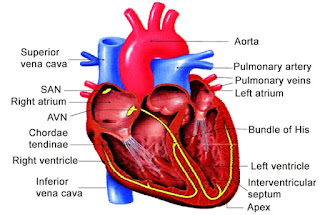Ncert shortnotes on (CNS) by MIRASRAR
__This is what i make for u is ncert shortnotes.
CENTRAL NERVOUS SYSTEM
- The brain is the central information processing organ of our body, and acts as the ‘command and control system’.
- It controls the voluntary movements, balance of the body, thermoregulation, and the brain also processes vision, hearing, speech etc.
- The human brain is well protected by the skull.
- Inside the skull, the brain is covered by cranial meninges consisting of an
- outer layer called dura mater
- a very thin middle layer called arachnoid
- and an inner layer called pia mater.
- The brain can be divided into three major parts:
- forebrain
- midbrain
- hindbrain

Fig. Brain
Forebrain
- The forebrain consists of
- cerebrum
- thalamus
- hypothalamus
- A deep cleft divides the cerebrum longitudinally into two halves, which are termed as the left and right cerebral hemispheres.
- The hemispheres are connected by a tract of nerve fibres called corpus callosum.
- The layer of cells which covers the cerebral hemisphere is called cerebral cortex and is referred to as the grey matter due to its greyish appearance.
- The cerebral cortex contains motor areas, sensory areas and large regions that are neither clearly sensory nor motor in function. These regions called as the association areas.
- Fibres of the tracts are covered with the myelin sheath, which constitute the inner part of cerebral hemisphere, which give an opaque white appearance to the layer and, hence, is called the white matter.
- The cerebrum wraps around a structure called thalamus, which is a major coordinating centre for sensory and motor signaling.
- Hypothalamus, another part of brain, lies at the base of the thalamus, which control body temperature, urge for eating.
- Hypothalamus also contains several groups of neurosecretory cells, which secrete hormones called hypothalamic hormones.
- The inner parts of cerebral hemispheres and a group of associated deep structures form a complex structure called the limbic lobe or limbic system.
Midbrain
- The midbrain is located between the thalamus/hypothalamus of the forebrain and pons of the hindbrain.
- A canal called the cerebral aqueduct passess through the midbrain.
- The dorsal portion of the midbrain consists mainly of four round swellings (lobes) called corpora quadrigemina.
- Midbrain and hindbrain form the brain stem.
Hindbrain
- The hindbrain comprises
- Pons
- cerebellum
- medulla
- Pons consists of fibre tracts that interconnect different regions of the brain, cerebellum has very convoluted surface in order to provide the additional space for many more neurons and the medulla of the brain is connected to the spinal cord.
- The medulla contains centres which control respiration, cardiovascular reflexes.




Good work .....rise n shine
ReplyDeleteThanku
DeleteShii hai boss........ U r doing the good job, this is what students want..
ReplyDeleteThanku g
DeleteKeeep going man ...
ReplyDeleteU r a gem❤️
Proud of u wallah
Thanku buddy
DeleteKeep supporting